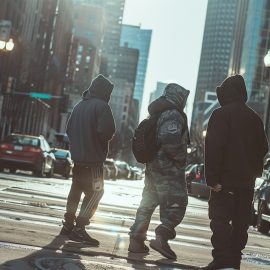

This article is an excerpt from the Shortform summary of "Hillbilly Elegy" by JD Vance. Shortform has the world's best summaries of books you should be reading.
Like this article? Sign up for a free trial here .
How flexible is socioeconomic mobility in America? Is socioeconomic mobility a myth? And when is economic mobility detached from social mobility?
Hillbilly Elegy sets out to explore the struggles of the rural white working class in 21st-century America and the barriers to socioeconomic mobility. The book tells a story of dysfunctional families; substance abuse; the material, spiritual, and moral decline of Appalachia; and the struggles to achieve true economic and social mobility in the United States.
Achieving Socioeconomic Mobility
Vance’s story of socioeconomic mobility starts with his own socioeconomic transition.
JD enlisted in the Marine Corps after graduating from high school. Enduring the emotional and physical toll of basic training taught him the virtues of self-reliance and showed him that he was capable of achieving far more than he had given himself credit for. He discovered that he had spent his whole life underestimating himself—thanks to his tumultuous upbringing in which he felt unloved and unwanted, and the hillbilly culture, which encouraged a deep pessimism and fatalism about one’s prospects in life.
After being discharged, JD went on to Ohio State and then to Yale Law School, where he discovered just how different his hillbilly upbringing had been from those of the upper-middle-class and wealthy people he was now surrounded with. At Yale, JD discovered the value of social capital—the networks of relationships that enable individuals to function and succeed. Having social capital meant access to people, institutions, and opportunities. JD realized how sorely lacking he’d been in this vital asset for all his life. But through determination, he learned how to hold his own in the elite circles of which he was now a part and built a life outside of the rough-and-tumble Appalachian world from which he’d come.
Economic Mobility, Social Stagnation
Is socioeconomic mobility always tied to both economic mobility and social mobility in America? Can you be economically mobile but fail to experience social mobility?
When he went to Ohio State and then to Yale Law School, JD learned to be a keen observer of how successful people thought and behaved versus how people in his community looked at the world. Having now lived in both worlds, he saw that true mobility in America was defined by more than wealth: social mobility in America mattered more than economic mobility. It wasn’t all about socioeconomic mobility. Even during periods where his family was earning good money and living in relative material comfort, they maintained all the same destructive social attitudes and dysfunctional modes of conflict resolution that were the inheritance of their hillbilly culture. From high divorce rates to domestic discord, they never made the transition to true middle-class standards of respectability.
Social Capital
Later on, in the white-collar professional world, JD discovered how much he truly had lacked in social capital—the networks of relationships that enable individuals to function and succeed. This lack of social capital put him and his community at a severe disadvantage and still represents a major barrier to social mobility in America.
Social Vs. Economic Mobility
This was core to their belief in the American Dream: that those who worked hard could achieve anything. JD’s Mamaw and Papaw, for all their flaws, worked tirelessly to give their children and grandchildren access to opportunities that they themselves never had. Mamaw always encouraged self-reliance: she cautioned JD to never be like the “fucking losers” who thought that their fate was beyond their control.
JD’s mom Bev’s marriage to a hillbilly stereotype like Bob showed Mamaw and Papaw that on some level, they had failed their daughter and grandchildren. What this illustrates is the distinction between economic mobility and social mobility. The Vance clan had certainly achieved the former: they were earning money well above and beyond what they could have in Kentucky. Even Bob made a comfortable living driving a truck.
But this newfound (relative) wealth never translated into true social mobility in America. Bev carried forward all the destructive social attitudes and dysfunctional modes of conflict resolution that she had learned from her childhood and that her parents had brought with them from their hillbilly culture in Kentucky. They may have been living a life of comparative material comfort, but the family was still saddled with the same harmful social values and norms.
JD was learning that social mobility in America was about more than raw earning power. He discovered that successful people followed a different set of norms and values than the white working-class hillbillies he grew up with.
Barriers to Social Mobility in America
These experiences showed JD just how different his upbringing had been from that of most of his classmates. He saw just how wide the gaps truly were between social classes and how pressures from both above and below inhibited social mobility in America.
From the top, elite institutions like Yale often deliberately excluded people with JD’s background from entering and accumulating the social capital they needed to succeed. As a case in point, one of JD’s professors firmly believed that Ivy League schools should refuse to admit students from non-elite state schools, regardless of the individual merit of the applicant.
But there were also pressures from the bottom. So much of hillbilly culture was rooted in resentment at “elites,” that being cut off from the world of Ivy League schools and white-collar jobs was worn as a badge of honor by many in JD’s community. At Yale, JD began to have guilt over having made it out of Middletown and felt that he was, in some way, a traitor to his culture and his class.
In researching the current state of the American Dream, JD saw that upward socioeconomic mobility was still attainable in places like the northeastern United States and much of Western Europe—it was in the South, the Rust Belt of the Midwest, and in Appalachia that poor kids were most likely to be trapped in a cycle of poverty.
In citing Raj Chetty’s study on social mobility in America, Vance noted that working-class kids in these regions lived in income-segregated communities—that is, they grew up only among other poor people, without exposure to affluence. They also were disproportionately likely to live in single-parent homes.
———End of Preview———

Like what you just read? Read the rest of the world's best summary of "Hillbilly Elegy" at Shortform . Learn the book's critical concepts in 20 minutes or less .
Here's what you'll find in our full Hillbilly Elegy summary :
- The hallmarks of hillbilly culture and why they hold people back
- How JD Vance broke out of his hillbilly childhood and graduated from Yale
- Why the author thinks hillbillies might be beyond saving






